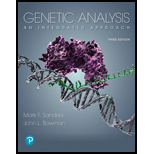
Concept explainers
You have four guinea pigs for a genetic study. One male and one female are from a strain that is pure-breeding for short brown fur. A second male and female are from a strain that is pure-breeding for long white fur. You are asked to perform two different experiments to test the proposal that short fur is dominant to long fur and that brown is dominant to white. You may use any of the four original pure-breed-ing guinea pigs or any of their offspring in experimental matings. Design two different experiments (crossing dif-ferent animals and using different combinations of pheno-types) to test the dominance relationships of alleles for fur length and color, and make predictions for each cross based on the proposed relationships. Anticipate that the litter size will be 12 for each mating and that female guinea pigs can produce three litters in their lifetime.
Want to see the full answer?
Check out a sample textbook solution
Chapter 2 Solutions
Genetic Analysis: An Integrated Approach (3rd Edition)
- when we collect fish or mussels we record a variety of biological information, including but not limited their sex, length, weight or a scale or finray or other tissue sample. Why do we do this, and what information are we hoping to obtain from these measurements and taking these samples?arrow_forwardDraw a rough sketch of the control and experimental data using a normal dose/response curve plot: i.e. % of total bound ligand vs. concentration. Indicate Kd and Bmax on this sketch. You don’t need to use exact numbers, but the relative proportions should be closearrow_forwardName something that could be happening to glutamate transporters that could have this effect on glutamate transport (i.e. the difference in glutamate transporters between control and experimental conditions). (Bonus: if you can also guess what the experimental condition is).arrow_forward
- a. For the control condition, calculate Kd. Include units and show your work. b. For the control condition, calculate Bmax. Include units and show your work. c. For the experimental condition, calculate Kd. Include units and show your work. For the experimental condition, calculate Bmax. Include units and show your work.arrow_forwardNow draw a rough sketch of what the control data might look like if in addition to the specific binding, there was also a considerable amount of nonspecific binding (again using a normal dose/response curve)arrow_forwarda. Which drug is the most potent? a,b,c,d,e b. Which drug has the highest efficacy?arrow_forward
- The shape of radishes may be long (SL/SL), oval (SL/SS), or round (SS/SS), and the color of radishes may be red (CR/CR), purple (CR/CW) or white (CW/CW). If a long, red radish plant is crossed with a round, white plant, what will be the appearance of the F1 and F2 generations?arrow_forwardNonearrow_forwardQuestion #3: In the KeyGene paper, the authors state that it would be useful if pollen from an apomict would transmit apomixis-inducing genes to the female in the cross (assuming the pollen is viable). Assuming there was just one gene conferring gametophytic obligate apomixis, and that the two parents are inbreds, what would be the consequences of such a cross if: a) The apomixis was a dominant trait? Indicate the genotypes and phenotypes (apomict or non- apomict) of the parents, F1 and F2 generations. Remember to include the expected genotypic and phenotypic ratios (or percentages) in the F1 and F2 generations, and to position the female first (left side) in the parental cross. b) The apomixis was a recessive trait? Indicate the genotypes and phenotypes (apomict or non- apomict) of the parents, F1 and F2 generations. Remember to include the expected genotypic and phenotypic ratios (or percentages) in the F1 and F2 generations, and to position the female first (left side) in the…arrow_forward
 Human Heredity: Principles and Issues (MindTap Co...BiologyISBN:9781305251052Author:Michael CummingsPublisher:Cengage Learning
Human Heredity: Principles and Issues (MindTap Co...BiologyISBN:9781305251052Author:Michael CummingsPublisher:Cengage Learning Human Biology (MindTap Course List)BiologyISBN:9781305112100Author:Cecie Starr, Beverly McMillanPublisher:Cengage Learning
Human Biology (MindTap Course List)BiologyISBN:9781305112100Author:Cecie Starr, Beverly McMillanPublisher:Cengage Learning Biology 2eBiologyISBN:9781947172517Author:Matthew Douglas, Jung Choi, Mary Ann ClarkPublisher:OpenStax
Biology 2eBiologyISBN:9781947172517Author:Matthew Douglas, Jung Choi, Mary Ann ClarkPublisher:OpenStax Concepts of BiologyBiologyISBN:9781938168116Author:Samantha Fowler, Rebecca Roush, James WisePublisher:OpenStax College
Concepts of BiologyBiologyISBN:9781938168116Author:Samantha Fowler, Rebecca Roush, James WisePublisher:OpenStax College Biology (MindTap Course List)BiologyISBN:9781337392938Author:Eldra Solomon, Charles Martin, Diana W. Martin, Linda R. BergPublisher:Cengage Learning
Biology (MindTap Course List)BiologyISBN:9781337392938Author:Eldra Solomon, Charles Martin, Diana W. Martin, Linda R. BergPublisher:Cengage Learning Biology Today and Tomorrow without Physiology (Mi...BiologyISBN:9781305117396Author:Cecie Starr, Christine Evers, Lisa StarrPublisher:Cengage Learning
Biology Today and Tomorrow without Physiology (Mi...BiologyISBN:9781305117396Author:Cecie Starr, Christine Evers, Lisa StarrPublisher:Cengage Learning





